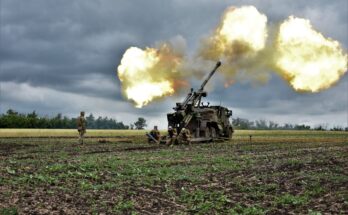A snapshot of recent news from sources around the world on the ongoing Russia-Ukraine war.

Political Developments
On Thursday, the European Union agreed to open accession talks with Ukraine, a decision Ukrainian President Volodymyr Zelensky applauded as “a victory Ukraine. A victory for all of Europe.” Kyiv has sought to join the political and economic bloc, but its bid had been stonewalled by Hungary.
President Zelensky visited Washington this week and is meeting with President Biden and lawmakers to discuss a new military strategy following Ukraine’s stalled counteroffensive. A growing number of conservatives are questioning the extension of military aid or are calling for a new military strategy before they sign off on more security assistance.
A Polish mayor reportedly ordered the lifting of a trucker blockade on a border crossing with Ukraine, temporarily reopening the crossing. Ukrainian truck drivers have permit-free access to the E.U., prompting complaints from Polish truckers, who have been blocking several crossings since November.
Kyivstar, a mobile phone and Internet operator, was hit by a massive cyberattack this week, knocking out service to subscribers. By Wednesday, the company said it had restored Internet connection to 93 percent of its customers. The Security Service of Ukraine (SBU) told RFE/RL it suspected Russian forces of being behind the attack.
Military Assistance to Ukraine
During his visit to the U.S., President Zelensky urged U.S. lawmakers to pass the $61 billion supplemental military aid package requested by the Biden administration. Washington’s Ukraine Security Assistance Initiative, a fund used to buy new weapons for Ukraine direct from manufacturers, ran out in October. The U.S. also only has $1 billion in drawdown funding remaining, which is the money used to replace weapons donated directly from U.S. inventories. Weapons donations will come to a halt of Congress doesn’t pass a new appropriations bill containing military aid.
In theory, the U.S. could continue donating its own weapons for a limited time before Congress approves money to replace them, but that increases the risk of the U.S. facing its own munitions shortfall.
Kyiv is in particular looking for the delivery of air-defense systems and other equipment that could help Ukraine control its airspace, which hasbeen contested throughout the conflict. President Zelensky said that Ukraine could “intensify our ground offensive in 2024 with our control of the skies: who controls the skies controls the war’s duration.”
On Tuesday, the Defense Department announced $200 million in aid to Ukraine, covering the delivery of AIM-9M missiles, HIMARS ammunition, 155mm and 105mm artillery rounds, anti-tank weapons, and other support equipment.
Bulgarian lawmakers overrode a presidential veto on the delivery of armored vehicles to Ukraine. The vote tally was 162-55 with no abstentions. Earlier this month, President Rumen Radev rejected the plans to transfer 100 armored personnel carriers to Kyiv, teeing up the second vote in the parliament.
Norway plans to deliver more NASAMS air-defense systems to Ukraine, the country’s government said this week, with an estimated value of NOK335 million ($31.9 million). “Some will be donated from Norway´s own storage in order to ensure fast delivery to Ukraine, while additional systems will be ordered from the industry for later delivery,” the government statement said.
Together with the U.K., Norway will also help develop Ukraine’s maritime capabilities, dubbing the initiative the “Maritime Capability Coalition.” Ukraine will receive amphibious vehicles, speedboats, and a pair of Sundown class minehunters.
Milrem Robotics and the Ukrainian Defense Industry (UDI) have signed an agreement to start forging next-generation multi-domain robotic defense systems. As a first step, the parties will start strategic cooperation in identifying Ukraine’s requirements and use cases for robotic systems which can enhance the capabilities of Ukraine’s armed units in the ongoing war and after the war.
A second German-delivered Patriot air-defense system will go into operation in Ukraine before the end of this year, Chancellor Olaf Scholz announced on Wednesday.
Scramble reported that Argentina will deliver a pair of Mil Mi-171E transport helicopters to Ukraine. The decision to send the helicopters follows the start of new President Javier Milei’s administration, which was inaugurated on December 10. President Zelensky traveled to Buenos Aires for the inauguration, his first tip to Latin America.
Canada delivered 11 Gurkha armored vehicles, for use in medical evacuation, to the Ukrainian military. Another two are still to arrive, according to Ukraine’s Minister of Digital Transformation, Mykhailo Fedorov.
Battlefield Updates
Given the uncertainty about the sustainability of Western military aid, Ukraine’s defense industry is aiming to ramp up production of “first person view” (FPV) drones — often used as loitering munitions — and upgrade their onboard systems to improve resiliency against Russian electronic warfare systems. Kyiv must also focus on its own electronic warfare systems to counter Russian FPV drones, Captain Iaroslav Kalinin told Defense One in an interview published this week.
“From Ukraine’s perspective, what we see right now is we need to produce tens of thousands of electronic countermeasure systems. We need to produce this locally as well as yesterday,” Captain Kalinin said.
Russian forces have become adept at jamming precision munitions the U.S. has donated to Ukraine, including the Guided Multiple Launch Rocket System and GPS-guided bombs. Russian jammers have also made it harder for Ukraine forces to operate drones and may be impacting satellite communications.
The Russian military is also installing Lesochek electronic warfare systems on its armored vehicles, President Vladimir Putin said this week. The system is used to disrupt remote-operated explosives, like IEDs.
A shortage of artillery shells is forcing Ukraine to limit its firing rate, soldiers told the BBC in an interview published on Thursday.
“During the peak period of the counter-offensive and even just a few months ago, the ratio between Russian and our artillery fire was largely 1:1 or bigger in our advantage. Now, we fire one round for every four or five rounds that Russia fires,” an anonymous Ukrainian drone operator deployed to the southern front told the BBC.
Russia launched a missile attack against Kyiv on Wednesday, injuring at least 53 people. Ukraine claims it intercepted all 10 ballistic missiles launched by Russia. There are concerns Russia is preparing for attacks on Ukraine’s power grid over the winter, mirroring attacks against energy infrastructure last year.
A Russian drone crashed in an uninhabited area in Romania following overnight attacks on Ukrainian port infrastructure on Wednesday, Romanian Ambassador to NATO Dan Neculăescu said in a statement on social media.
L3Harris Technologies’ Vehicle Agnostic Modular Palletized ISR Rocket Equipment (VAMPIRE) multi-purpose weapons systems are having an immediate impact in Ukraine’s wartime efforts. VAMPIRE enables Ukrainian ground forces to target and destroy enemy drones and defend against adversary ground threats.
Russia has reportedly produced its own kamikaze uncrewed surface vessel (USV), called the BBKN Dandelion. The USV is produced by Kingisepp Machine-Building Plant and is an answer to the Ukrainian-operated USVs that have targeted the Black Sea Fleet and military infrastructure in Crimea.
For 50 years, Forecast International intelligence reports have been the aerospace and defense industry standard for accurate research, analysis, and projections. Our experienced analysts compile, evaluate, and present accurate data for decision makers. FI's market research reports offer concise analysis of individual programs and identify market opportunities. Each report includes a program overview, detailed statistics, recent developments and a competitive analysis, culminating in production forecasts spanning 10 or 15 years. Let our market intelligence reports be a key part of reducing uncertainties and mastering your specific market and its growth potential. Find out more at www.forecastinternational.com



